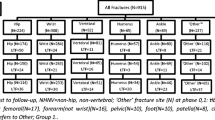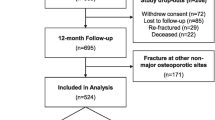Abstract
Summary
Health-related quality of life in elderly women with sustained incident fractures was assessed prospectively for 1 year, using the EuroQol standard. Loss of QOL was more severe in patients after hip or vertebral fractures than those with wrist fracture. QOL was not completely restored in patients suffering from hip fracture.
Introduction
Osteoporosis-related fractures decrease mobility, social interaction, and emotional well-being. All of these characteristics determine health-related quality of life (HR-QOL). In this study, we assessed HR-QOL in elderly women following incident clinical fractures.
Methods
Thirty-seven patients with hip fractures (mean age 76.1 years), 35 with vertebral fractures (mean age 72.6 years), and 50 with wrist fractures (mean age 68.6 years) were enrolled. HR-QOL was prospectively measured using EuroQol (EQ-5D) before the fracture, 2 weeks, 3 months, 6 months, and 1 year after the fracture.
Results
During the observation period, reduction of EQ-5D values was greatest in the hip fracture group. In the wrist fracture group, EQ-5D values at 6 months after the fracture showed recovery; however, in the hip and vertebral fracture groups, recovery was significantly lower than before the fracture. One year after the fracture, EQ-5D values were not significantly different from prefracture values in the vertebral and wrist fracture groups, but remained significantly lower in the hip fracture group.
Conclusions
Loss of QOL was more severe in patients after hip or vertebral fractures than in patients with wrist fracture. HR-QOL was not completely restored in patients suffering from hip fracture.



Similar content being viewed by others
References
Lofman O, Berglund K, Larsson L et al (2002) Changes in hip fracture epidemiology: redistribution between ages, genders and fracture types. Osteoporos Int 13:18–25
Jaglal SB, Weller I, Mamdani M et al (2005) Population trends in BMD testing, treatment, and hip and wrist fracture rates: are the hip fracture projections wrong? J Bone Miner Res 20:898–905
Melton LJ 3rd, Atkinson EJ, Madhok R (1996) Downturn in hip fracture incidence. Public Health Rep 111:146–150 discussion 151
Kannus P, Niemi S, Parkkari J et al (2006) Nationwide decline in incidence of hip fracture. J Bone Miner Res 21:1836–1838
Rowe SM, Song EK, Kim JS et al (2005) Rising incidence of hip fracture in Gwangju City and Chonnam Province, Korea. J Korean Med Sci 20:655–658
Hagino H, Katagiri H, Okano T et al (2005) Increasing incidence of hip fracture in Tottori Prefecture, Japan: trend from 1986 to 2001. Osteoporos Int 16:1963–1968
Hagino H, Yamamoto K, Ohshiro H et al (1999) Changing incidence of hip, distal radius, and proximal humerus fractures in Tottori Prefecture, Japan. Bone 24:265–270
Boonen S, Autier P, Barette M et al (2004) Functional outcome and quality of life following hip fracture in elderly women: a prospective controlled study. Osteoporos Int 15:87–94
Brenneman SK, Barrett-Connor E, Sajjan S et al (2006) Impact of recent fracture on health-related quality of life in postmenopausal women. J Bone Miner Res 21:809–816
Tidermark J, Zethraeus N, Svensson O et al (2002) Femoral neck fractures in the elderly: functional outcome and quality of life according to EuroQol. Qual Life Res 11:473–481
Marcus R, Wong M, Heath H 3rd et al (2002) Antiresorptive treatment of postmenopausal osteoporosis: comparison of study designs and outcomes in large clinical trials with fracture as an endpoint. Endocr Rev 23:16–37
Brazier JE, Green C, Kanis JA (2002) A systematic review of health state utility values for osteoporosis-related conditions. Osteoporos Int 13:768–776
Dolan P, Gudex C, Kind P et al (1996) The time trade-off method: results from a general population study. Health Econ 5:141–154
Ikeda S, Ikegami N (2001) Preference-based measure(EQ-5D) In: Ikegami N, Fukuhara S, Shimozuma K, Ikeda S (eds) QOL evaluation handbook for clinical practice(in Japanese). Igakushoin, Tokyo, pp 14–18
Ikeda S, Ikegami N (1999) Health status in Japanese population: results from Japanese EuroQol study. Iryou to Shakai 9:83–92
Nawata S, Yamad Y, Ikeda S et al (2000) EuroQol study of the elderly general population: Relationship with IADL and other attributes. Iryou to Shakai (in Japanese) 10:75–86
Hallberg I, Rosenqvist AM, Kartous L et al (2004) Health-related quality of life after osteoporotic fractures. Osteoporos Int 15:834–841
Lips P, van Schoor NM (2005) Quality of life in patients with osteoporosis. Osteoporos Int 16:447–455
Oleksik AM, Ewing S, Shen W et al (2005) Impact of incident vertebral fractures on health related quality of life (HRQOL) in postmenopausal women with prevalent vertebral fractures. Osteoporos Int 16:861–870
Dhillon V, Hurst N, Hannan J et al (2005) Association of low general health status, measured prospectively by Euroqol EQ5D, with osteoporosis, independent of a history of prior fracture. Osteoporos Int 16:483–489
Sakamoto K, Nakamura T, Hagino H et al (2006) Report on the Japanese Orthopaedic Association’s 3-year project observing hip fractures at fixed-point hospitals. J Orthop Sci 11:127–134
Cranney AB, Coyle D, Hopman WM et al (2005) Prospective evaluation of preferences and quality of life in women with hip fractures. J Rheumatol 32:2393–2399
Hall SE, Williams JA, Senior JA et al (2000) Hip fracture outcomes: quality of life and functional status in older adults living in the community. Aust N Z J Med 30:327–332
Fierens J, Broos PL (2006) Quality of life after hip fracture surgery in the elderly. Acta Chir Belg 106:393–396
Randell AG, Nguyen TV, Bhalerao N et al (2000) Deterioration in quality of life following hip fracture: a prospective study. Osteoporos Int 11:460–466
Oleksik A, Lips P, Dawson A et al (2000) Health-related quality of life in postmenopausal women with low BMD with or without prevalent vertebral fractures. J Bone Miner Res 15:1384–1392
Cockerill W, Lunt M, Silman AJ et al (2004) Health-related quality of life and radiographic vertebral fracture. Osteoporos Int 15:113–119
Dolan P, Torgerson D, Kakarlapudi TK (1999) Health-related quality of life of Colles’ fracture patients. Osteoporos Int 9:196–199
Lips P, Cooper C, Agnusdei D et al (1999) Quality of life in patients with vertebral fractures: validation of the Quality of Life Questionnaire of the European Foundation for Osteoporosis (QUALEFFO). Working Party for Quality of Life of the European Foundation for Osteoporosis. Osteoporos Int 10:150–160
NOF (1998) Osteoporosis: review of the evidence for prevention, diagnosis and treatment and cost-effectiveness analysis. Introduction. Osteoporos Int 8(Suppl 4):S7–S80
Acknowledgments
The authors thank Masatoshi Nakashima, M.D., Masaaki Shimizu, M.D., Kimiko Tsuda, M.D., and Noboru Yamagata, M.D., for their help and support.
Conflicts of interest
None.
Author information
Authors and Affiliations
Corresponding author
Rights and permissions
About this article
Cite this article
Hagino, H., Nakamura, T., Fujiwara, S. et al. Sequential change in quality of life for patients with incident clinical fractures: a prospective study. Osteoporos Int 20, 695–702 (2009). https://doi.org/10.1007/s00198-008-0761-5
Received:
Accepted:
Published:
Issue Date:
DOI: https://doi.org/10.1007/s00198-008-0761-5




